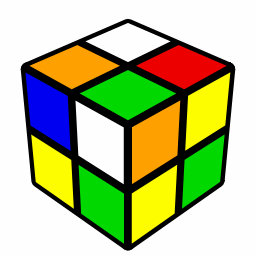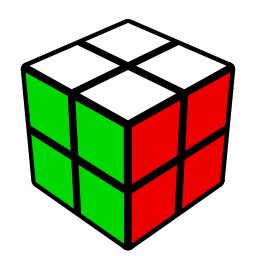2x2x2 Rubik's cube - solving methods
 |
 |
On this quite outdated page (from 2010, next update is not planned) you can see some solving methods for the 2x2x2 Rubik's cube. Principle of both widely used methods (Ortega, CLL) and rather theoretical ones (OFOTA, G-FASSST) is described.
On this page you will find:
Intuitive method
Basic characteristics: a method designed for those who don't want to memorize algorithms
Advantage: no need to memorize algorithms
Disadvantage: usually very high number of moves
Tutorial on one possible intuitive solution for a 2x2x2 Rubik's cube
LBL
(Layer By Layer) - basic characteristics: a method designed for beginners, takes three steps, requires 8 algorithms (excluding symmetrical cases)
Step 1: intuitive solution of one layer
Step 2: OLL (Orientation of Last Layer)
Step 3: PLL (Permutation of Last Layer)
Advantage: relatively frequent skip of the last step
Disadvantage: relatively high number of moves
Curiosity: although this method is generally not recognized as the fastest one, Edouard Chambon from France has been able to break the world record with it in the average time of 3.74 seconds
Ortega
Basic characteristics: a method designed for advanced ones, named after Victor Ortega, takes three steps, requires 11 algorithms (excluding symmetrical cases)
Step 1: intuitive solution of one face
Step 2: orientation of opposite face
Step 3: permutation of both layers
Advantage: easy-to-memorize method
Disadvantage: on average, higher move count in comparison with a comparable Guimond method
Curiosity: Josef Jelínek from the Czech Republic had merit in method popularization
Video in which Syuhei Omura from Japan solves a cube in the average time of 3.45 seconds (I got the exactly same result - see a corners-first method), using the Ortega method
Guimond
Basic characteristics: a method designed for experienced ones, named after Gaétan Guimond, takes four steps, requires 13 algorithms (excluding symmetrical cases)
Step 1: intuitive solution of exactly ¾ of a face that may contain opposite colors
Step 2: orientation of opposite faces that may contain opposite colors
Step 3: correct orientation of both faces
Step 4: permutation of both layers
Advantage: on average, lower move count in comparison with a comparable Ortega method
Disadvantages: high number of steps. It requires 21 algorithms if symmetrical cases are included. On the contrary, the Ortega method requires only 12 algorithms if symmetrical cases are included
Curiosity: the world record hasn't been ever broken with this method (in case of average solve) unlike
the Ortega method, LBL or CLL
Video in which Gabriel Dechichi Barbar from Brazil solves a cube in the average time of 3.46, using the
Guimond method
SOAP
(Separate, Orient All, Permute) - basic characteristics: a method designed for connoisseurs, takes three steps, requires 59 algorithms
Step 1: intuitively separate two opposite colors into respective layers so that at least two adjacent cubies would be correctly oriented
Step 2: orientation of opposite faces
Step 3: permutation of both layers
Advantage: especially in combination with the SS method it forms a strike weapon for speedsolving. Moreover, the method has a room for further improvement
Disadvantage: longer and not easily executable algorithms in comparison with similar methods
Sortega
Basic characteristics: a method designed for artists, named partly after the Ortega method and partly after the English word sort, takes four steps, requires 78 algorithms
Step 1: intuitive creation of a 1x1x2 block of the same color and its placement to the bottom-left position on a cube
Step 2: orientation of opposite faces that may contain opposite colors
Step 3: correct orientation of both faces
Step 4: permutation of both layers
Advantage: steps 2 and 3 can be always solved using only R and U moves which are quickly executable in general
Disadvantage: if we don't trace cubies while solving, transition from the second to the third step can
be quite slow-pacing
CLL (part of the EG method)
(Corners of Last Layer) - basic characteristics: a method designed for connoisseurs, takes two steps, requires 42 algorithms
Step 1: intuitive solution of one layer
Step 2: solution of the second layer
Advantage: on average, lower number of moves than methods mentioned till now
Disadvantage: more difficult case recognition (in order to execute an algorithm) than methods mentioned
till now
Curiosity: the method is currently (2010) very popular among speedcubers
Note: CLL = OLL + PLL
Video in which Łukasz Ciałoń from Poland solves a cube in the average time of 2.98 seconds, using the CLL method
pi(g) CLL (part of the EG method)
Basic characteristics: a method designed for connoisseurs, takes two steps, requires 42 algorithms
Step 1: intuitive solution of ½ of a layer
Step 2: solution of the second layer + correction of the 1st layer
Advantage: similar to CLL
Disadvantage: similar to CLL
Curiosity: although the CLL and pi(g) CLL methods are fairly similar, pi(g) CLL has by no means such amount of popularity as CLL
OFOTA
(Orient opposite Face, OrienT, All) – basic characteristics: a method designed for artists, takes three steps, requires 82 algorithms (excluding symmetrical cases)
Step 1: intuitive solution of one face that may contain opposite colors
Step 2: orientation of opposite faces
Step 3: permutation of both layers
Advantage: including symmetrical cases, the OFOFTA method has the lowest number of algorithms from the best methods
Disadvantage: I cannot think of any ;-)
Curiosity: right now it is rather theoretical method barely used in practice
EG
Basic characteristics: a method designed for experts, named after Erik Akkersdijk and Gunnar Krig, takes two steps, requires 3·42 = 126 algorithms (but can be reduced to 2·42 using the anti-CLL technique)
Step 1: intuitive solution of one face, ½ of a layer or one layer
Step 2: permutation of the 1st layer + solution of the second layer
Advantages: on average, very low number of moves. More experienced cubers are able to solve the puzzle in one look in some cases, the method is very ambitious in terms of speedcubing - it is one of the most commonly used methods by 2x2x2 world speedcubing leaders
Disadvantage: difficult case recognition in order to execute an algorithm
Curiosity: the method has been already known since the 80's of the last century, however, it has been exposed
to more detailed analysis as late as around 2005
Note: EG = pi(g) CLL (also known as EG 1) + CLL + a case when only one face is solved in the first step (known as EG 2)
Video in which Anthony Brooks from the USA solves a cube in the average time of 2.79 seconds, using the EG
method
Video explaining the anti-CLL technique
SS
Basic characteristics: a method designed for experts, named after Timothy Sun and Mitchell Stern, takes three steps, requires 61 algorithms (excluding symmetrical cases)
Step 1: intuitive solution of at least ¾ of one face
Step 2: orientation of opposite faces
Step 3: permutation of both layers
Advantage: easier case recognition in order to execute an algorithm in comparison with the CLL, EG, partially OFOTA method
Disadvantage: I cannot think of any ;-)
Curiosity: since Erik Akkersdijk invented this method, it should be properly called ASS. However, this term has already a meaning in English, thus Erik Akkersdijk has been deleted from the name
Video in which David Woner from the USA solves a cube in the average time of 2.75 seconds, mainly using
the SS method
BRASS
(Bar, Reduce, And SS) - basic characteristics: a method designed for experts, takes three steps, requires 114 algorithms
Step 1: intuitive solution of a half of a layer (1x1x2 block) at the bottom-left position + corner permutation at the right-back position
Step 2: cube reduction in such a way so that the next step could be solved only by R and U moves + corner orientation at the right-back-bottom position
Step 3: solution of five remaining corners
Advantage: similarly to the Sortega or SS method, there are often used R and U moves which are executable very quickly
Disadvantage: time-consuming case recognition
Curiosity: due to its complexity, I am not aware of a person who would use this method as his/her main
G-FASSST
(Guimond - First And Second Steps Squished by Thomas) - basic characteristics: a method designed for magicians, takes three steps, requires 587 algorithms (excluding symmetrical cases)
Step 1: intuitive solution of at least ¾ of one face that may contain opposite colors
Step 2: orientation of opposite faces
Step 3: permutation of both layers
Advantage: G-FASSST fully covers the SS (thus also Guimond and Ortega) and OFOTA methods
Disadvantage: absurd number of algorithms
Curiosity: when picking a method name, e.g. these proposals have been suggested: OMFG (Oh My ... Frank
Morris), ONLYPHIL (only Phil), 731-132 (Phil method, just under 600 algorithms), ZB++Pocket
(more algorithms than ZB [a method designed for the 3x3x3 cube] has, on a pocket cube) or SWOT
Furthermore, after deciding to name it G-FASST, correct English pronunciation has been suggested as well:
a) Go fast
b) Je(zus) fast
The page was graphically improved by Michael Feather.